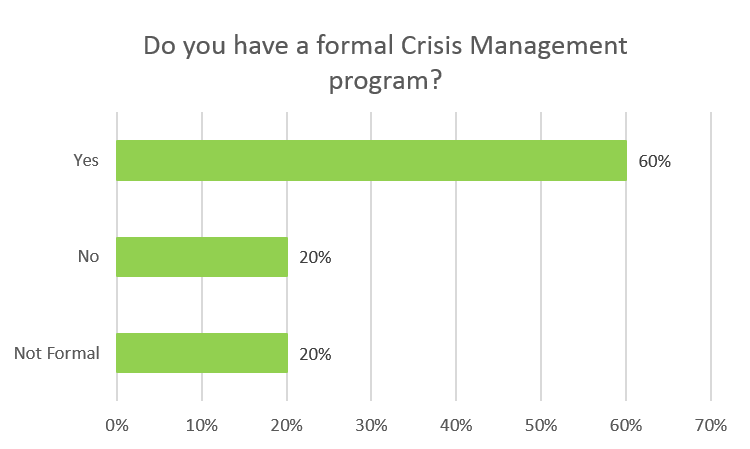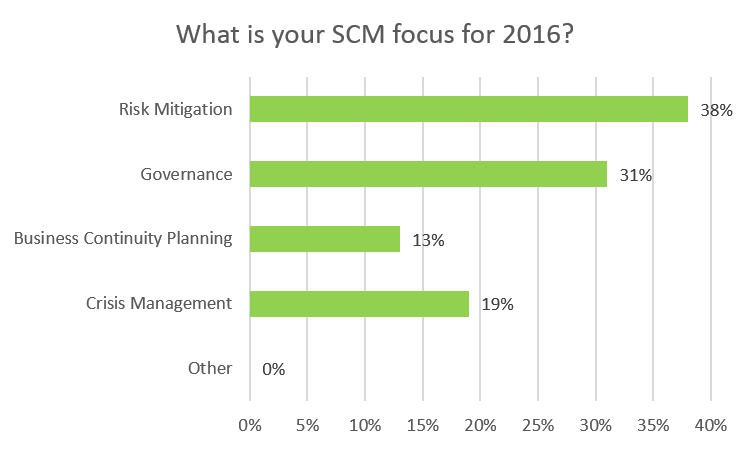Across companies and industries, there is a growing awareness of the importance of supply chain risk management and resiliency programs. However, establishing an enterprise-wide supply chain risk management and resiliency program within your company doesn’t happen overnight, nor should it. It’s a multi-pronged process unique to each company, and each company is at a different stage of awareness, preparation, implementation, adaptation and maturation.
On the second day of the recent annual Global Supply Chain Resiliency Council event, we held a live poll at the conclusion of our customer training sessions to gauge where attendees were in their respective SCRM and resiliency journeys. The supply chain practitioners in attendance represent some of the largest companies with the most extensive global supply chains. As such, this post provides our poll’s findings to give you a better sense of where other major companies are in their SCRM journeys, and as to why they choose to pursue supply chain resiliency.

You will see that companies of all sizes, regardless of industry, can fall along a “resiliency spectrum”. While some are well into implementing and maturating their supply chain risk management and resiliency programs, others are still gaining awareness and planning their processes.

Major supply chain disruption events, a.k.a black swan events, can take a tremendous toll on business continuity and revenue, affecting some companies and industries more than others. When we published the whitepaper “Tianjin Explosions Global Supply Chain Impact: It’s Worse than You Think”, we predicted that the crisis was, as the title suggests, worse than you would think. As the poll data suggests, the Tianjin explosions truly did have a far-reaching, rippling impact across industries.

Black swan events are unpredictable and can take a major toll on an enterprise. Having a formal Crisis Management program gives companies a significant competitive advantage when confronted with unexpected crises. As the poll indicates, Crisis Management programs are growing more common among enterprises with complex multi-tier supply chains. Given that 40% of the polled attendees either did not have a formal Crisis Management program or have non-centralized Crisis Management processes, it is fair to assume that companies that have implemented a cohesive Crisis Management program are better suited to respond and mitigate major supply chain disruptions than those that are not fully prepared.

It is important for SCM departments to identify their weak spots and figure out how they can become more resilient in the coming year. Nearly one third of the polled attendees recognized that governance, or the structures and processes by which supply chain constituents share power, can always have room for improvement and lubrication. One fifth wanted to bolster their Crisis Management programs to be resilient in the face of unexpected crises. About one sixth of the attendees want to address their business continuity planning. Nevertheless, risk mitigation appears to be the most common arena for improvement among companies across industries.

Some companies’ SCRM programs are driven from the top-down, while others are driven from the SCM upwards – the motivations to manage risk and become resilient are as varied as risk itself.
Learn More About SCRM and Supply Chain Resiliency
As the global supply chain risk terrain continues to evolve, companies across all industries realize they need to adapt. Although addressing and preparing for the encompassing scope of supply chain risk may be intimidating, waiting for risks to manifest and maintaining a reactive stance towards the supply chain risk can be far more damaging to a company’s revenue and brand.
For those who are unfamiliar with Resiliency, we highly encourage that you download “The Ultimate Guide to Supply Chain Resiliency”. In this document, we provide supply chain risk management practitioners with concrete suggestions and guidance on how to create, roll-out, and institutionalize a global supply chain resiliency program (SCRP). The premise of this guide is that there is an unserved need for information on the topic of building and managing a SCRP that adequately addresses the crucial initial phase of building the business case, establishing strategic alignment, and securing executive sponsorship.




